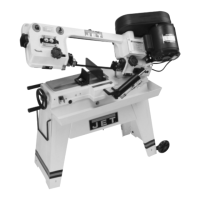18
12.0 Troubleshooting the J-3130 and J-3230
Table 4
Symptom Possible Cause Correction
Excessive blade
breakage.
Material loose in the vise. Use more pressure to tighten vise.
Check right jaw pivot and lock bolts for
tightness.
Check left jaw pivot bolt for looseness -- be
certain the jaw is not tilting upward when you
apply pressure to the work in the vise.
If you are stacking multiple pieces in the vise,
be sure all of the pieces are captured by the
vise pressure.
Incorrect feed or speed. Check technical literature for recommended
feeds and speeds for the material and blade
you are using.
Check chip formation to adjust speed and feed
to correct rate when sawing.
Incorrect blade tension. Adjust blade tension to where it just does not
slip on the wheel.
Teeth in contact with work before saw is
started.
Be sure the saw motor has come fully up to
speed before beginning a cut and be sure the
blade is not resting on the work piece before
the motor has come up to full speed.
Blade rubs on wheel flange. Use paper cutting method of adjusting blade
tracking. See Blade Tracking .
Check drive and idler wheels for looseness in
mounting parts or worn/damaged bearings.
Misadjusted blade guides. Adjust blade guides.
Blade too thick for wheel diameter Use a thinner blade. Check with your blade
supplier for recommendations on blade
thickness for a specific wheel diameter.
Cracking at weld Replace blade.
Premature blade
dulling.
Teeth too coarse. Use finer tooth blade.
Blade speed too high. Try next lower speed or check technical
literature for specific recommendations
regarding speeds for specific blade and
material being cut.
Check with materials supplier for
recommendations on the work piece material
supplied.
If using coolant, check with supplier regarding
correct coolant for the job.
Inadequate feed pressure. Increase pressure while observing chip
formation to be sure you are cutting efficiently.
Hard spot or scale on material. Reduce speed of blade.
Increase feed pressure in scale or hard spots.
Work hardening of material (especially
stainless steel).
Work hardening materials such as stainless
require a heavy, continuous cut. Be sure you
are using a sharp blade, then, if necessary,
release some counterbalance spring pressure
by loosening the tension nut if work hardening
of the material is a problem.
Blade installed backwards. Reinstall blade so teeth point toward right end
of saw.

